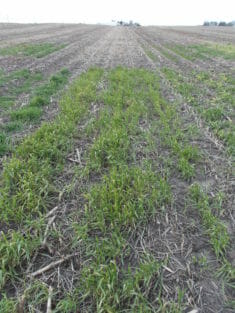Replant Decisions for Winter Small Grains
Last fall was wonky. Harvest was late and many people didn’t make it into the fields until November to establish their winter small grains – a month or more after optimal planting dates for yield. On top of it we’ve had some bitterly cold stretches this winter with little snow cover, so some folks are wondering – is my cereal rye and/or winter wheat going to make it? Should I go to plan B? Right now is the time to evaluate if it’s a good enough stand to keep for grain or treat it as a cover crop and terminate before planting corn or soybeans.

Cereal Rye
First off, winter small grains are not created equal. Cereal rye is far more winter hardy than winter wheat so it’s more likely to emerge from this weird winter with grace. “It’s a survivor,” Keota farmer Tim Sieren says. “Rye will germinate at 35 degrees so it will green up in time for you to evaluate the stand and decide whether you keep it and over-seed clover or not.”
Agronomist Margaret Smith explains the plant physiology that makes cereal rye able to emerge and produce grain, even if you don’t see it emerge in the fall. “The meristem of the rye – the area of growing and dividing cells – requires vernalization (cold treatment) to allow the rye to become reproductive later this spring and to produce seed. Rye needs only to germinate to become vernalized, even if the meristem is still underground and it will make a crop the following year.” Even if you didn’t see any growth last fall, it’s still likely that the rye has germinated during a stretch of warmer days and will emerge in the spring. So don’t give up hope yet on your cereal rye!
Now that it’s started to warm up more, it’s time to get out in the field and look at the plant stand. For rye, an ideal plant stand is 20 to 24 live plants per square foot, but the Alberta Agriculture and Forestry Department suggests that five to six live plants per square foot is a keeper stand. To verify the plants are alive you should dig up a few plants and verify that there’s new pure white and thick roots coming out of the crown. Even if the tops are brown, if the roots are actively growing the plants will recover.

Assess plant stands by measuring a square foot and counting live plants within it
But a late planting date in the fall for cereal rye will affect grain yields, even if you have total survival through the winter and achieve the target plant stand. Margaret says, “Based on our experiences on our farm, you will be looking at an upside of 25 to 30 bu/acre rye grain yield this year with an early November planting date.”
Winter Wheat
Winter wheat is more dainty than cereal rye. It cannot survive extended periods of cold in the winter without snow over it. For the most part, the wheat will be fine if crown temperatures (soil temperatures) stay at -4°F or above throughout the winter. With no snow on the ground, -20°F are fatal for winter wheat, and -15°F can only be tolerated for 12 hours or less. Snow cover mitigates the temperature for the crown greatly. Only 1.2 inches of snow will keep crown temperatures above 0°F at -22°F air temperatures. NDSU and UMN both have extensive publications on winter wheat survival that you can access here. Based on the temperature data in your area, you should be able to estimate whether or not you are in the “danger zone” of having stand loss due to winter kill.
If you are doubtful that your wheat will return in the winter, it’s time for a field test. Unfortunately, wheat is more sluggish to emerge from dormancy in the spring than rye so it may require an indoor survival test to evaluate the plant stand. To do this remove plants from one square foot of the field or one foot of row on a warm day – being careful to protect the plants if the air temperature is lower than the soil temperature. Then take the plants into the warm house and place them on a moist paper towel or other medium (soil, sand, cloth) and cover. Make sure the plant crowns stay moist. If the plants are alive they will put out new white roots from the crown in just a few days. Using this method, you can tell your plant population even if the wheat hasn’t broken dormancy yet.
Then you can extrapolate wheat yields from that plant population. University of Nebraska estimates that 3 healthy plants per foot of 7.5 inch spaced rows will yield 24 bushels/acre. You can access the full matrix of live plants and row spacing from UNL here. Though these yields are not directly transferable to Iowa conditions, they still give a ballpark estimate for yield.

Large gaps in the wheat stand can cause serious weed problems — and should be a factor in replant decisions.
If you have patchy winter survival with low spots that died completely, keep in mind that those areas will become thickets of weeds. If the dead patches are few and can easily be seeded with some rye or winter wheat or spot treated with herbicide then you can do that to control weeds, but if the stand is patchy all over, it will be a serious challenge to manage the weeds in that field – so be sure to walk the field and get a sense of the evenness of the stand, not only the plant population in one square foot.
From there it’s up to you to pencil out the scenarios and determine if you keep the stand for grain or pivot to use the field as a cover crop and terminate it before planting another crop. To stay in the loop on the latest small grains happenings sign up for our small grains newsletter by contacting alisha@practicalfarmers.org.

